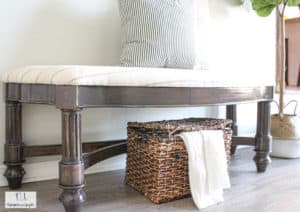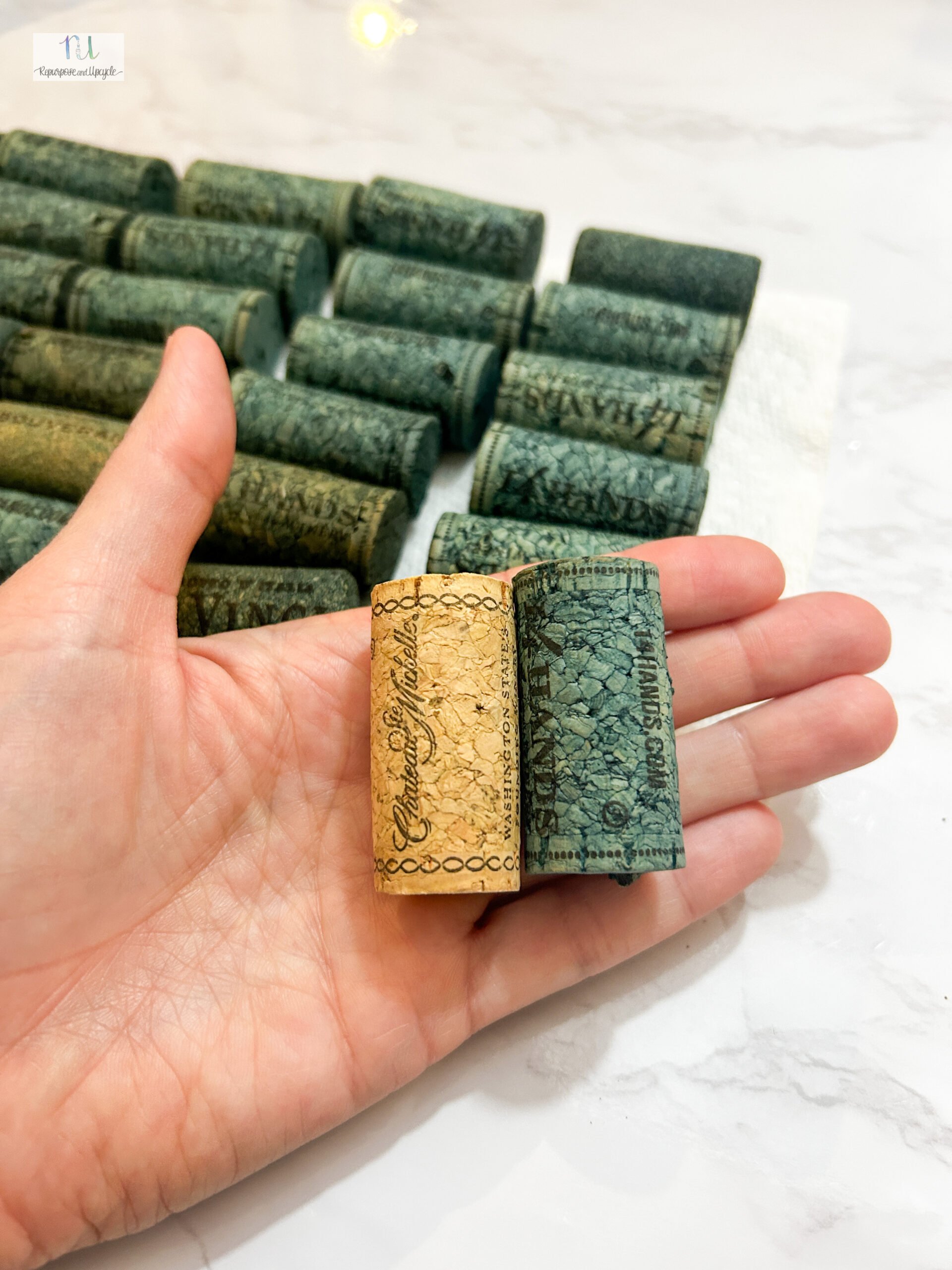If you’ve ever wondered about wood dye vs. wood stain then this is the post for you! I’ve shared the differences between wood dye (wood tint) and wood stain and how to use each.
I bet most of you reading this haven’t heard of wood dye. Why would anyone use wood dye (also known as wood tint)? We hear about wood stain every day but until last year I hadn’t heard of wood dye. When I first heard of it I had so many questions. What is it made from? Is it water based or oil based or both? I was curious to try this new wood finish. I’m going to share all about the pros and cons of wood dye vs. wood stain and why you would use each. Just remember, every different type of wood will create a different wood finish so test a small area first to make sure it will create the desired result.
Before we dive into why you would use each, I want to talk about what they are first.
What is wood stain?
Wood stains are primarily used to color wood while they sometimes provide a protection to the top layer or finish coat of the wood. There are two main types of stains; oil based and water based.
Wood stains can even be created from household items like coffee and tea! Today I’m talking about the store bought wood stains. Most of the time stain is purchased in a can or wood stain kits.

Types of wood stain categories
There are two main types of dye stain categories; Penetrating and surface finishes.
Penetrating wood stains
These are products that seep down in the wood and dry inside the wood (also called pigment stains). These are best applied with a cloth and really give the color of wood that natural finish because they don’t hide the natural grain of the wood. You can see how I used this type of stain to refinish our wood stairs.
Surface wood stains
These are just as they say; the product dries on the surface of the wood. These stains make wood more durable because they protect the surface and can be used as for outside wood projects due to their UV protection. Surface stains are typically the best choice for high traffic wood stains and create a more uniform coverage due to the fact that they cover the wood grain a little more effectively. Examples of surface stains are products like Varathane and Minwax stains. I recently stained an outdoor planter with Valspar’s one coat exterior stain. Gel stains are also a surface stain because they don’t penetrate the wood.
Pros of Oil based wood stain:
- Requires longer dry time which allows for a more even finish
- More durable
- Less maintenance
- Most common type of stain
Pros of water based wood stain:
- Dries quickly
- No harsh fumes
- Easy cleanup
- penetrates the wood deeper
Most people know what wood stain is and have probably used it at least once for a wood project. You can see where I applied wood stain over a bench that had been previously stained below. This created a lovely custom color on the bench.

Enough about wood stain, let’s talk about wood dye or wood tint.
What is wood dye or wood tint?
Wood dye (also known as wood tint) is comprised of a colorant and a solvent (like a fast-drying alcohol base or even water). This gives you some flexibility to create oil based wood finishes or water-based dye stains with your own colour creation. Unlike regular wood stain, which mostly sit on the top of the wood surface, wood dye (sometimes called solvent-based wood stains) penetrates the wood and colors the wood from within. The color is more translucent than the color from a traditional wood stain and you have more options to create coats of different color dyes. If you are looking for a more prominent wood grain in the appearance of wood, wood dye is probably the right finish for you.
You can purchase wood dye in liquid form or powder form. Wood dye powders are probably more common as they allow you to create your own custom colors.
Why you would use wood dye vs. wood stain?
Wood stains are used to not only color the wood, but often times they are used to add a layer of protection to it.
Wood dyes, on the other hand, penetrate the wood and do not give a protective layer like most wood stains do.
Like I said earlier, wood dyes are more translucent. This is helpful when you want the wood grain to show. The dyes are made of much smaller molecules than wood stains, so UV light can pass through them easier.
This is good in one sense, like if you want wood grain to show, but not good if you want to protect the surface of the wood. You always need to add a top coat or sealer to a surface that you’ve applied wood dye to. Using a clear acrylic spray lacquer is an easy product to use after you’ve dyed a wood surface.
Wood stains are similar to paint in that they both are primarily surface coatings. Dyes, on the other hand, penetrate deep because the molecules are smaller.
Wood dyes are great to use when whitewashing a furniture piece, especially if you want to whitewash in different colors and create different effects in the wood.
Also, wood dyes can be mixed into solvents like Shellac, lacquers or water based finishes.
If you want to achieve a rich color, you can use both together! Apply the wood dye first so it penetrates the wood and then add the stain over it. There are a handful of different ways to use each!
You can see where I applied aniline dyes with a Keda Wood Dye product to a wood cutting board to create a beautiful colorful decor piece!

Disclosure; this post contains affiliate links. As an Amazon Associate I earn from qualifying purchases. This disclosure statement refers to the rest of the Amazon links in this post. See more on my disclosure page.
Pros of Wood Dye:
- Translucent
- No harmful odors
- Comes in an array of colors
- Easy clean up
- Can be mixed with other solvents and sealers
Pros of Wood Stain:
- Very Durable
- Easier to apply because they don’t dry as quick as wood dye’s
- Works better with outdoor wood
- Comes in either oil or water-based finishes
Where do you buy wood tint?
I purchased my wood tint on Amazon. It’s a product called TransTint Dyes in the color Dark Mission Brown. It comes in a liquid form.
This particular product comes in an array of new colors with brilliant transparent colors.

If you are looking for a powder dye form, check out this Keda dye kit with a few different dye colors. There are a handful of other wood dye products like General Finishes dye stains that come in an array of premixed colors.
How to apply wood stains and wood dyes
Here are the general steps for applying wood stains and dyes:
- Prepare the wood surface: Sand the wood to create a smooth and even sanded surface and to open the pores in preparation for staining. Remove any dust or debris from the wood using a tack cloth.
- Test the stain or dye: Before applying the stain or dye to the entire piece of wood, it’s a good idea to test it on a small area to ensure it achieves the desired color.
- Apply the stain or dye: Using high-quality range of brushes, lint free cloth, or sponge and apply a coat of stain or dye in the direction of the wood grain. Work in small sections to ensure even coverage. Allow the stain or dye to penetrate the wood for the recommended amount of time, typically 5-15 minutes.
- Wipe off excess: After the stain or dye has penetrated the wood, use a clean cloth to wipe off any excess. Wipe in the direction of the wood grain to avoid streaks or uneven coloring.
- Allow to dry: Let the stained or dyed wood dry completely according to the manufacturer’s instructions. This may take several hours, so be patient.
- Apply a topcoat (optional): Depending on the type of stain or dye used, you may need to apply a topcoat for added protection and a glossy finish. Follow the manufacturer’s recommendations for the specific product you are using.
Remember to always follow the instructions provided by the manufacturer of the wood stain or dye for the best wood finishing results.
I hope this post has helped you better understand how to use wood stain vs. how to use wood dye. Ultimately, the finished product will depend on the wood type and which finish you choose. Always test a small area before diving into a big project.
Thanks for stopping by!
Lindsey**





